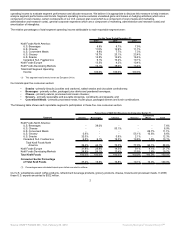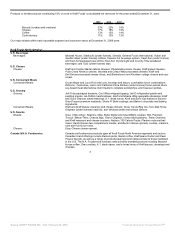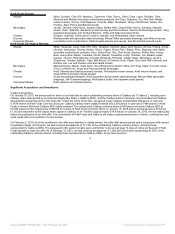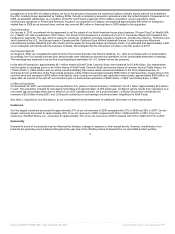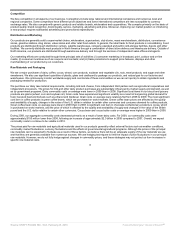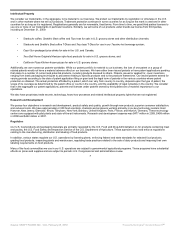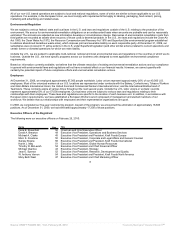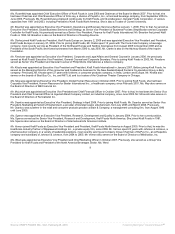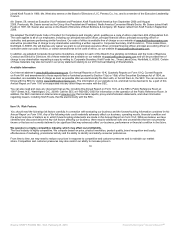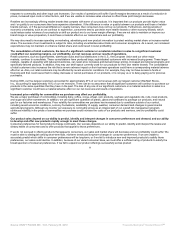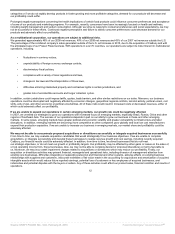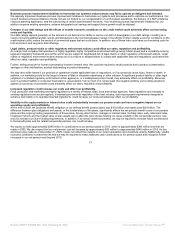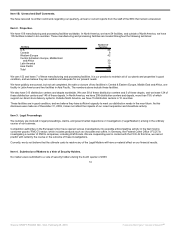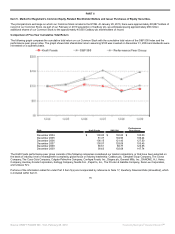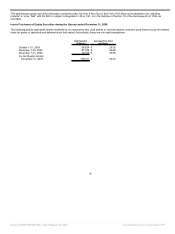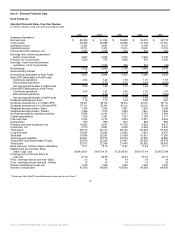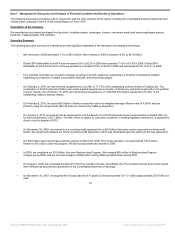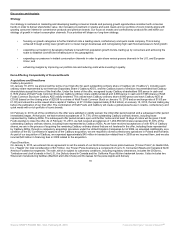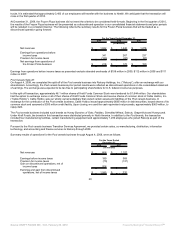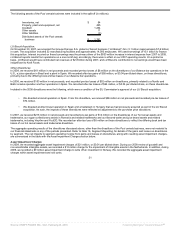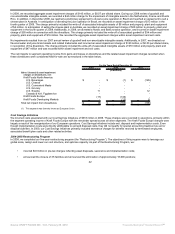Kraft 2009 Annual Report Download - page 15
Download and view the complete annual report
Please find page 15 of the 2009 Kraft annual report below. You can navigate through the pages in the report by either clicking on the pages listed below, or by using the keyword search tool below to find specific information within the annual report.
categories or if we do not rapidly develop products in faster growing and more profitable categories, demand for our products will decrease and
our profitability could suffer.
Prolonged negative perceptions concerning the health implications of certain food products could influence consumer preferences and acceptance
of some of our products and marketing programs. For example, recently, consumers have been increasingly focused on health and wellness,
including weight management and sodium consumption. Although we strive to respond to consumer preferences and social expectations, we may
not be successful in these efforts. Continued negative perceptions and failure to satisfy consumer preferences could decrease demand for our
products and adversely affect our profitability.
As a multinational corporation, our operations are subject to additional risks.
We generated approximately 48% of our 2009 net revenues, 49% of our 2008 net revenues and 43% of our 2007 net revenues outside the U.S.
The percentage of the combined company’s sales generated outside of the U.S. will increase in 2010, due to the acquisition of Cadbury and with
the anticipated sale of our Frozen Pizza business. With operations in over 70 countries, our operations are subject to risks inherent in multinational
operations, including:
• fluctuations in currency values,
• unpredictability of foreign currency exchange controls,
• discriminatory fiscal policies,
• compliance with a variety of local regulations and laws,
• changes in tax laws and the interpretation of those laws,
• difficulties enforcing intellectual property and contractual rights in certain jurisdictions, and
• greater risk of uncollectible accounts and longer collection cycles.
In addition, certain jurisdictions could impose tariffs, quotas, trade barriers, and other similar restrictions on our sales. Moreover, our business
operations could be interrupted and negatively affected by economic changes, geopolitical regional conflicts, terrorist activity, political unrest, civil
strife, acts of war, and other economic or political uncertainties. All of these risks could result in increased costs or decreased revenues, either of
which could adversely affect our profitability.
If we are unable to expand our operations in certain emerging markets, our growth rate could be negatively affected.
In 2007, we unveiled our strategies to grow our operations with increased focus on emerging markets, especially Brazil, Russia, China and other
regions of Southeast Asia. The success of our operations depends in part on our ability to grow our business in these and other emerging
markets. In some cases, emerging markets have greater political and economic volatility and greater vulnerability to infrastructure and labor
disruptions. In addition, emerging markets are becoming more competitive as other companies grow globally and local low cost manufacturers
expand their production capacities. If we are unable to increase our business in emerging markets, our market share and profitability could be
adversely affected.
We may not be able to consummate proposed acquisitions or divestitures successfully or integrate acquired businesses successfully.
From time to time, we may evaluate acquisition candidates that would strategically fit our business objectives. If we are unable to complete
acquisitions, or integrate successfully and develop these businesses to realize revenue growth and cost savings, including recently acquired
Cadbury, our financial results could be adversely affected. In addition, from time to time, we divest businesses that do not meet
our strategic objectives, or do not meet our growth or profitability targets. Our profitability may be affected by either gains or losses on the sales of,
or lost operating income from, those businesses. Also, we may not be able to complete desired or proposed divestitures on terms favorable to
us. Moreover, we may incur asset impairment charges related to acquisitions or divestitures which may reduce our profitability. Finally, our
acquisition or divestiture activities may present financial, managerial and operational risks, including diversion of management attention from
existing core businesses, difficulties integrating or separating personnel and financial and other systems, adverse effects on existing business
relationships with suppliers and customers, inaccurate estimates of fair value made in the accounting for acquisitions and amortization of acquired
intangible assets which would reduce future reported earnings, potential loss of customers or key employees of acquired businesses, and
indemnities and potential disputes with the buyers or sellers. Any of these activities could affect our product sales, financial condition and results of
operations.
12
Source: KRAFT FOODS INC, 10-K, February 25, 2010 Powered by Morningstar® Document Research℠


